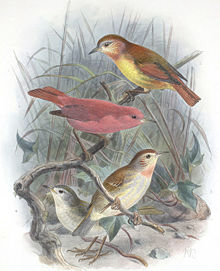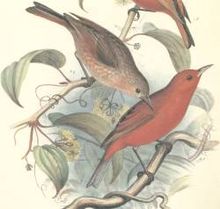- Molokai Creeper
-
Kākāwahie 
Above: adult male and female. Below: juvenile male and female Conservation status Scientific classification Kingdom: Animalia Phylum: Chordata Class: Aves Order: Passeriformes Family: Fringillidae Genus: Paroreomyza Species: P. flammea Binomial name Paroreomyza flammea
(Wilson, 1889)Paroreomyza flammea, commonly known as the Kākāwahie or Molokaʻi Creeper, was a species of finch in the Hawaiian honeycreeper subfamily, Drepanidinae. It is extinct, but formerly occurred on the Hawaiian island of Molokaʻi in Hawaii. It was 5.5 in (14 cm) long with clawed toes. This bird had the appearance of a ball of flame, especially males, which were scarlet red all around. The female had more of a brownish tinge to its belly. Its call was a chip like someone was cutting up wood in the distance. They were discovered in the late 19th century when Scott Barchard Wilson, a British ornithologist was lost in the fog. Wilson had shot down a female and two bright males. He collected several specimens and skins of other species of Molokai birds and then went back to England. They were fast flitting birds but nevertheless, they were still endangered. It is depicted in several paintings from the early 18th, 19th, and 20th centuries.
Contents
Distribution
The Kākāwahie lived in the Akoke Forests. Its stronghold in the Akoke Forests was the Kamokau Plateau, where it would always be seen before disappearing in 1963.
Habits
Apparently similar to the Maui Nui ʻAlauahio, it used its blunt and short beak to peck out insects from old naio (Myoporum sandwicense) trees. It mainly fed on the larvae of beetles and lepidoptera; however in rare cases, it sipped nectar from flowers, which included the naio. The exterior of its nest was reportedly composed of moss. The binomial name of this species, Paroreomyza flammea, refers to its appearance being to similar to that of a ball of fire as it flit from tree to tree in search of invertebrates.
Extinction
Causes of extinction were probably similar to those of other Hawaiian forest birds. Habitat destruction, avian disease spread by introduced mosquitoes, as well as introduced predators were all likely major factors in its decline. Diseases spread by mosquitoes included avian malaria and fowlpox. These diseases caused the Kākāwahie to grow ill and create lumps, which eventually caused paralysis and then death by starvation. Native Hawaiians trapped the birds for their red feathers, which were then used in the capes and leis of aliʻi (nobles and royalty). It was last sighted in montane wet forest at ʻŌhiʻalele Plateau in 1963. However there were reports of this bird holding on until the 1970s, but after that it was definitely extinct.
References
- BirdLife International 2004. Paroreomyza flammea. 2006 IUCN Red List of Threatened Species. Downloaded on 19 July 2007.
- Birds of North America Online. [1]. Downloaded on Jan. 12 2010
External links
- 3D view of specimens RMNH 110.003 and RMNH 110.004 at Naturalis, Leiden (requires QuickTime browser plugin).
- "Kākāwahie or Moloka‘i Creeper" - Hawaii's Comprehensive Wildlife Conservation Strategy (.pdf)
Categories:- IUCN Red List extinct species
- Drepanidinae
- Animals described in 1889
- Endemic fauna of Hawaii
- Extinct Hawaiian animals
- Bird extinctions since 1500
Wikimedia Foundation. 2010.


